
A hybrid vehicle is one that uses two or more distinct types of power, such as submarines that use diesel when surfaced and batteries when submerged. Other means to store energy include pressurized fluid in hydraulic hybrids.
Power-to-weight ratio (PWR) is a calculation commonly applied to engines and mobile power sources to enable the comparison of one unit or design to another. Power-to-weight ratio is a measurement of actual performance of any engine or power source. It is also used as a measurement of performance of a vehicle as a whole, with the engine's power output being divided by the weight of the vehicle, to give a metric that is independent of the vehicle's size. Power-to-weight is often quoted by manufacturers at the peak value, but the actual value may vary in use and variations will affect performance.
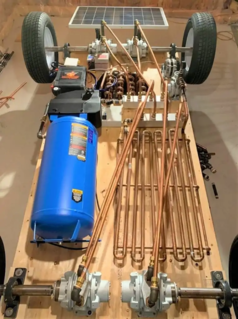
A compressed-air car is a compressed-air vehicle fuelled by pressure vessels filled with compressed air and propelled by the release and expansion of the air within a Pneumatic motor or motor adapted to compressed air. The car can be powered solely by air, or combined with gasoline, diesel, ethanol, or an electric plant with regenerative braking. Compressed-air cars operate according to a thermodynamic process where air cools down when expanding and heats up when being compressed and those are thermal energy losses that drain the capacity factor of compressed air, however with the recent developments in isothermal compressed air energy storage ICAES plants, compressed air storage has reached 4 times the capacity factor of lithium-ion batteries with 2.7Mj/kg or 3.6Mj/m3 and in 2020 there has been developments in ICAV car or isothermal compressed air vehicle published by Dr. Reza Alizade Evrin from Ontario Tech University with a first prototype that uses low pressure air tanks and exhaust air recovery to power a paraffin heat exchanger system with a global energy efficiency of 74% with a driving range of 140 km. This efficiency and range can be increased by using storage tank as car chassis structure, high pressure tanks, new rotary engines, and a more efficient heat exchanger, this breakthrough together with the availability of recycled and bio-based thermoplastics for tanks and pneumatic components and renewable energy means this technology can be the basis of a free green transportation revolution with energy and circular industry decentralization with open source numerical control machines fabrication including additive manufacturing while multistage air compressors and coolers or hydraulic pumps can be attached directly to VAWT wind turbines, stirling engine with a parabolic or fresnel lens solar concentrator or river, tidal, wave hydropower turbine with no electric energy or electric grid needed nor energy conversion inefficiencies or additional energy storage, also instead of onboard heat recovery system there can be used a refillable molten salt reservoir in a heat exchanger system.

A lithium-ion battery or Li-ion battery is a type of rechargeable battery in which lithium ions move from the negative electrode through an electrolyte to the positive electrode during discharge, and back when charging. Li-ion batteries use an intercalated lithium compound as the material at the positive electrode and typically graphite at the negative electrode.

The Suzuki Ignis is a subcompact car that was first produced by Suzuki in 2000, replacing the Suzuki Cultus, and subsequently as a small crossover from 2016.
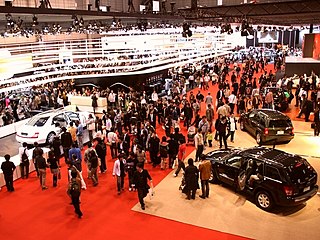
The Tokyo Motor Show (東京モーターショー) is a biennial auto show held in October–November at the Tokyo Big Sight, Tokyo, Japan for cars, motorcycles and commercial vehicles. Hosted by the Japan Automobile Manufacturers Association (JAMA), it is a recognized international show by the Organisation Internationale des Constructeurs d'Automobiles, and normally sees more concept cars than actual production car introductions which is the reason why the auto press see the show as one of the motorshow's big five.

The Subaru R1e was a battery-electric microcar produced by Fuji Heavy Industries (FHI), first shown at the 2003 Tokyo Motor Show. The concept was jointly developed to prototype form with Tokyo Electric Power (TEPCO), the giant Japanese utility company. At least 40 prototypes were built by FHI and tested by TEPCO and the New York Power Authority. The vehicle had a range of 80 kilometres (50 mi) and a top speed of 100 km/h (62 mph).
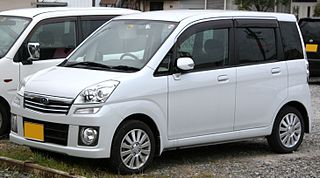
The Subaru Stella is a 5-door kei car produced by Subaru starting in June 2006. The Stella is based on the same architecture as the Subaru R2. It can be considered as a direct replacement of the Subaru Pleo, although the Pleo soldiered on for another four years. It was Subaru's re-entry into the market segment dominated by the Suzuki Wagon R and the Daihatsu Move, hoping to recapture market share after the R2's lower-than-expected sales. The Stella's dimensions are more parking structure-friendly where vehicle stacking is utilized over the Pleo. The most recent generation Stella is a rebadged Daihatsu Move.
MIEV or MiEV is the name given by Japanese automaker Mitsubishi Motors (MMC) to its alternative propulsion technologies. From late 2006, “MiEV” encompasses all of Mitsubishi Motors’s electric drive systems work, including lithium-ion batteries, in-wheel motors and other technologies related to electric vehicle(EV), hybrid-electric vehicle and fuel-cell vehicles.

The Audi e-tron is a series of electric and hybrid cars shown by Audi from 2009 onwards. In 2012 Audi unveiled a plug-in hybrid version, the A3 Sportback e-tron, released to retail customers in Europe in August 2014, and slated for the U.S. in 2015. A decade after the unveiling of the first e-tron concept at the 2009 International Motor Show Germany, Audi's first fully electric e-tron SUV went into production in 2019.

Audi hybrid vehicles are hybrid electric vehicles created by the German carmaker, Audi. Some vehicles listed were concept vehicles, which utilised an internal combustion engine and an electric motor, and were used for research and development (R&D) for potential future use of the technology into possible series production. Audi launched its first hybrid concept car in 1989 called the Audi Duo, and was the first European company to sell a hybrid in 1997, though only in very small numbers.
Mahindra Electric Mobility Limited, formerly known as the Reva Electric Car Company, is an Indian company based in Bangalore, involved in designing and manufacturing of compact electric vehicles. The company's first vehicle was the REVAi electric car, available in 26 countries with more than 4,000 of its different versions sold worldwide by mid-March 2011. Reva was acquired by Indian conglomerate Mahindra & Mahindra in May 2010. After the acquisition, the company launched the electric hatchback e2o in 2013. Today, the company sells electric vehicles in different segments – the electric sedan eVerito, the electric commercial vehicle eSupro, and the Treo range of low maintenance, lithium-ion battery-powered three-wheelers. Recently, Mahindra Electric became the first Indian car manufacturer to cross 170 million kilometers traveled on its fleet.
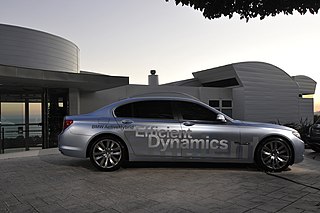
The BMW Concept 7 Series ActiveHybrid is a concept car developed by BMW and presented at the Paris Motor Show in October 2008. It is BMW's first mild hybrid and second hybrid concept vehicle after the BMW Concept X6 ActiveHybrid, BMWs first full hybrid revealed at the 2007 Frankfurt Motor Show. Both models will be ready for mass production at the end of 2009.
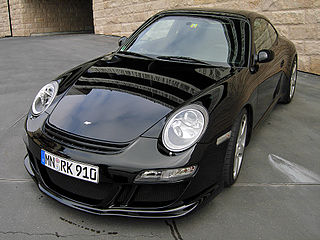
The eRuf Model A was a late-2000s all-electric concept sports car built by German automobile manufacturer Ruf Automobile. The car was powered by a UQM Technologies propulsion system. The car has a top speed of 225 km/h (140 mph) and was capable of producing 150 kW of power and 479 lb⋅ft (649 N⋅m) of torque. Estimated range per charge was 250–320 km (155–199 mi), depending on performance level, using iron-phosphate, lithium-ion batteries built by Axeon plc of Great Britain. During coasting the engine works as a generator producing electricity to charge the batteries.

Subaru (スバル) is the automobile manufacturing division of Japanese transportation conglomerate Subaru Corporation, the twenty-first largest automaker by production worldwide in 2017.

The BYD F6 is a midsize sedan produced by the Chinese manufacturer BYD.

The Subaru B5-TPH was a concept shooting-brake coupe with a Turbo Parallel Hybrid (TPH) powertrain made by Fuji Heavy Industries (FHI), introduced at the 2005 Tokyo Motor Show.

The Subaru Hybrid Tourer is a hybrid concept sport utility/grand touring vehicle designed and built by Subaru, unveiled at the 2009 Tokyo Motor Show. The Hybrid Tourer included several signature Subaru design features, such as the use of a horizontally-opposed engine and all-wheel drive, and built on prior Subaru hybrid concepts such as the B9SC and B5-TPH by using a two-motor layout. The Hybrid Tourer was succeeded by the 2011 Advanced Tourer concept and the 2013-15 VIZIV diesel hybrid concept series.
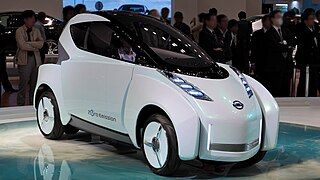
The Nissan Land Glider is an electric concept car presented by the Japanese car manufacturer Nissan at the 2009 Tokyo Motor Show.


















